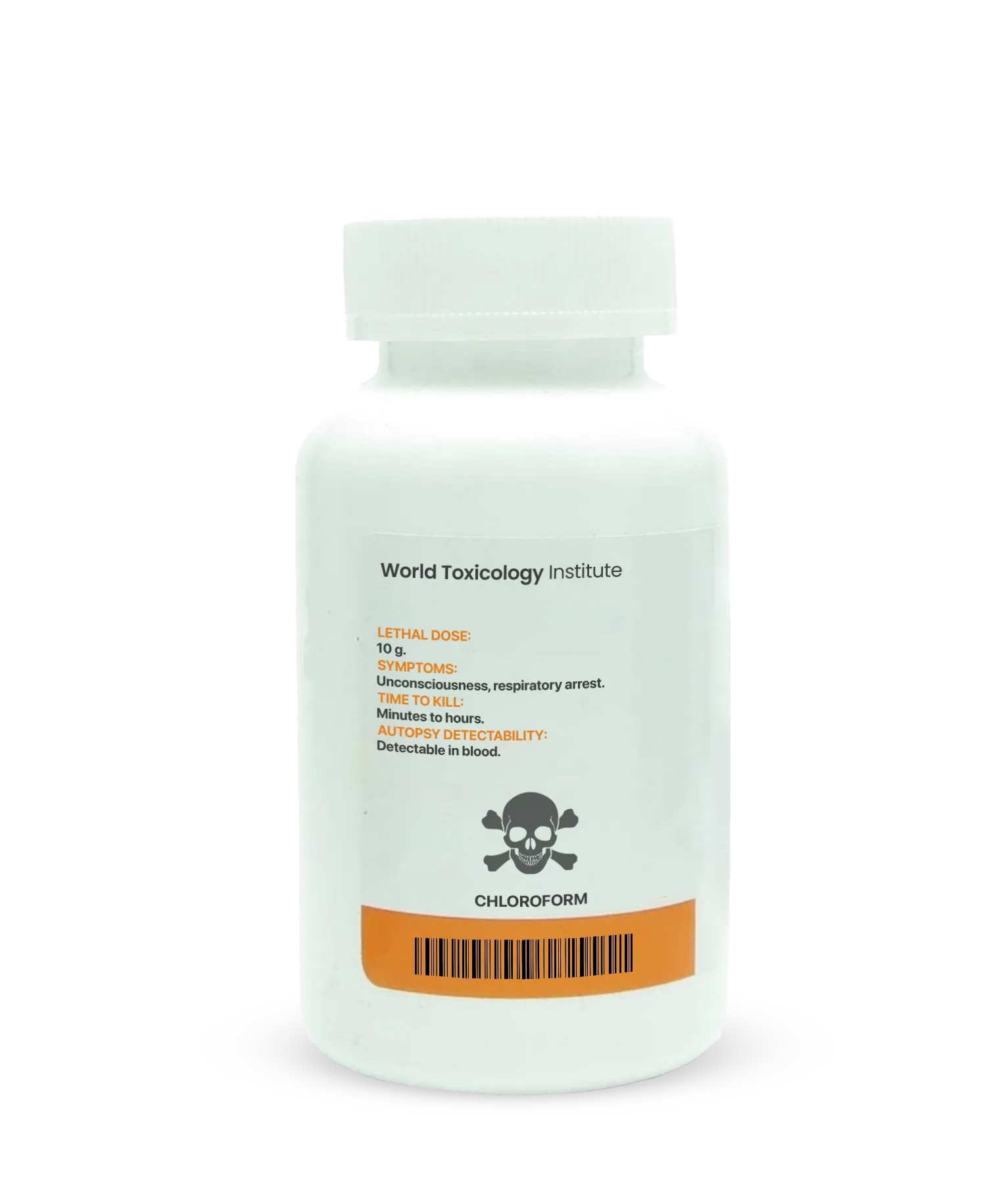Description
Chloroform Poisoning: A Comprehensive Overview
Introduction
Chloroform, a colorless, sweet-smelling organic compound, has historically been used as a solvent, anesthetic, and in the production of other chemicals. While it has legitimate industrial and laboratory applications, chloroform exposure can pose significant health risks, including poisoning and long-term health effects. Understanding the properties, sources, mechanisms of action, symptoms of poisoning, and treatment options for chloroform exposure is crucial for safety and health.
Properties
- Chemical Formula: CHCl₃
- Molecular Weight: 119.38 g/mol
- Appearance: Chloroform is a colorless liquid with a distinctive sweet smell.
- Melting Point: -63.5 °C (-82.3 °F)
- Boiling Point: 61.2 °C (142.2 °F)
- Solubility: Chloroform is insoluble in water but soluble in organic solvents.
Sources of Exposure
Chloroform can be encountered in various settings, including:
- Industrial Applications: Used as a solvent in the production of pesticides, dyes, and pharmaceuticals.
- Laboratory Use: Commonly used as a solvent and reagent in chemical laboratories.
- Anesthesia: Historically used as an anesthetic, although its use has largely been replaced by safer alternatives due to health risks.
- Environmental Contamination: Chloroform can be found in drinking water, particularly in areas with industrial pollution or the use of chlorinated disinfectants.
- Household Products: Some cleaning agents and degreasers may contain chloroform.
Mechanism of Action
Chloroform exerts its effects primarily through its action on the central nervous system (CNS). Its mechanisms include:
- CNS Depressant: Chloroform is a potent CNS depressant, leading to sedation and anesthesia. It affects neurotransmitter systems and alters neuronal excitability.
- Hepatotoxicity: Prolonged exposure can lead to liver damage, as chloroform is metabolized by the liver, producing toxic metabolites.
- Respiratory Effects: Chloroform can depress respiratory function, leading to hypoxia and respiratory failure in severe cases.
Symptoms of Chloroform Poisoning
Symptoms of chloroform poisoning can vary based on the route of exposure (inhalation, ingestion, or skin contact) and the dose. Common symptoms include:
- Inhalation Exposure:
- Dizziness
- Headaches
- Nausea and vomiting
- Confusion and disorientation
- Respiratory depression
- Ingestion:
- Abdominal pain
- Nausea and vomiting
- Diarrhea
- Drowsiness
- Loss of consciousness
- Skin Contact:
- Irritation or dermatitis
- Absorption can lead to systemic effects if large areas of skin are exposed.
Lethal Dose
The lethal dose of chloroform can vary widely depending on individual susceptibility and exposure circumstances. Generally, inhalation of high concentrations (greater than 1000 ppm) can be fatal within minutes. Ingestion of larger quantities (greater than 30 ml) may also be lethal.
Time Needed to Kill
The onset of symptoms can occur rapidly, particularly with inhalation exposure. Severe symptoms can develop within minutes to hours, and without prompt medical intervention, death can occur within hours due to respiratory failure or cardiovascular collapse.
Detection in Autopsy
Detection of chloroform in autopsy can involve several methods:
- Tissue Analysis: Chloroform can be detected in various tissues, including liver, lungs, and blood.
- Blood and Urine Tests: Analytical techniques such as gas chromatography or mass spectrometry may be employed to confirm the presence of chloroform in biological samples.
- Histopathological Examination: Autopsy may reveal evidence of organ damage, particularly in the liver and lungs.
Antidote and Treatment
Immediate medical attention is crucial for anyone suspected of chloroform poisoning. Treatment strategies include:
- Decontamination: If exposure is recent, activated charcoal may be administered to limit absorption, provided the patient is conscious and can swallow.
- Supportive Care: This includes intravenous fluids to maintain hydration and electrolyte balance, as well as monitoring of vital signs and organ function.
- Respiratory Support: In cases of respiratory depression, supplemental oxygen or mechanical ventilation may be required.
- Symptomatic Treatment: Managing symptoms like nausea, vomiting, and pain can be achieved with appropriate medications.
- Monitoring for Complications: Patients should be closely monitored for potential complications such as liver failure or respiratory issues.
Prevention
Preventive measures are essential to avoid chloroform poisoning:
- Regulation: Stricter regulations on the sale and distribution of chloroform-containing products can help reduce the risk of misuse.
- Public Awareness: Education on the dangers of using unregulated solvents and the risks of industrial exposure can prevent accidental poisoning.
- Proper Handling in Industrial Settings: Implementing safety protocols and personal protective equipment (PPE) can minimize the risk of exposure in workplaces where chloroform is used.
Conclusion
Chloroform is a potent chemical compound that poses serious health risks, especially when misused or encountered in industrial settings. Understanding the sources, mechanisms of action, symptoms, and treatment options for chloroform poisoning is crucial for prevention and effective management. Prompt medical intervention can significantly improve outcomes for those affected by chloroform toxicity.
Chloroform toxicity, symptoms of chloroform poisoning, treatment for chloroform poisoning, sources of chloroform, prevention of chloroform toxicity, lethal dose of chloroform, acute chloroform exposure, chloroform health risks, chloroform metabolites, chloroform effects on the body








Reviews
There are no reviews yet.